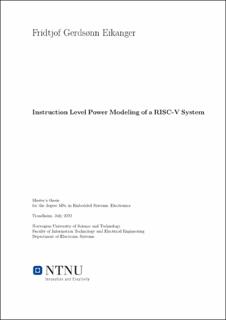| dc.contributor.advisor | Kursun, Volkan | |
| dc.contributor.advisor | Lopez Tello Villafuerte, Luis David | |
| dc.contributor.author | Eikanger, Fridtjof Gerdsønn | |
| dc.date.accessioned | 2022-11-22T18:19:29Z | |
| dc.date.available | 2022-11-22T18:19:29Z | |
| dc.date.issued | 2022 | |
| dc.identifier | no.ntnu:inspera:104140281:34471686 | |
| dc.identifier.uri | https://hdl.handle.net/11250/3033495 | |
| dc.description.abstract | Estimering av effekt i innvevd programvare er til nytte for både hardware- og firmwareutviklere. ILPM er en estimeringsmetodikk som er raskere men mindre nøyaktig enn RTL-simuleringer. Vi viser at et sett med data-avhengige regresjonsvariabler, kan en ILPM-modell nå en værstefallsfeil på 3.52% med en R2-verdi på 0.775. Effekten av for mange variabler analyseres òg. | |
| dc.description.abstract | The estimation of power usage in embedded software is useful for developers of both hardware and firmware. Instruction-Level Power Modeling (ILPM) is a method of estimating such power usage which is faster but less accurate than Register-Transfer Level (RTL) simulations. We show that with a collection of data-dependent features added to a standard ILPM model, the worst case error of power estimation in one two-stage pipelined RISC-V CPU is 3.52%, with an R-squared of 0.775. The effects of adding too many features to a model is also analyzed. | |
| dc.language | eng | |
| dc.publisher | NTNU | |
| dc.title | Instruction-Level Power Modeling of a RISC-V System | |
| dc.type | Master thesis | |
